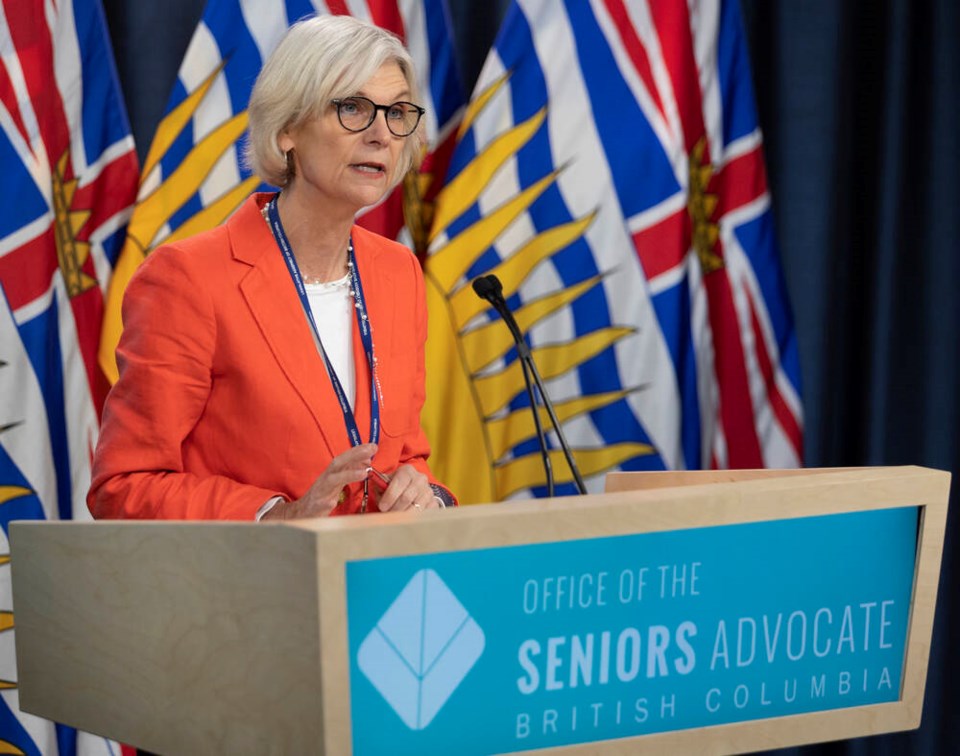Seniors Advocate Isobel Mackenzie is calling on the province to eliminate or drastically reduce home-support fees for seniors within the year, saying the high cost is prematurely forcing people into long-term care.
Most provinces don’t charge for home support, and of those that do, B.C. is the most expensive, said Mackenzie, who released her latest report on home support at the legislature press theatre on Thursday.
Mackenzie said B.C. has twice as many low-care-needs seniors in long-term care as Alberta and Ontario, two provinces that do not charge for home-support service. The total number of seniors in long-term care in B.C. is above the national average, the report says.
She argues it would cost health authorities $14,000 annually to provide one hour of home support per day compared with $60,000 annually for a long-term care bed for a senior with an income of $29,000 per year.
“The world has not fallen apart in Alberta and Ontario where they do not charge for this,” said Mackenzie. “They can do this immediately.”
Home-support services are also free in Manitoba, Prince Edward Island, Yukon, Northwest Territories, and Nunavut. In Quebec, clients receive a refundable tax credit for home support.
In provinces that charge for home support, the annual cost for one-hour daily visits is $1,494 in Nova Scotia, $4,906 in Newfoundland and Labrador, and $5,917 in New Brunswick.
In B.C., the annual cost to clients for one-hour daily visits is $8,952 — even for a senior with an annual income of only $29,000, said Mackenzie, adding she has previously raised the issue of home-support costs with the government.
Health Minister Adrian Dix, responding to the report, said 70 per cent of clients in B.C. who are below the income threshold pay no fees for home support, while another 15 per cent have their fees capped at $300.
Dix said the province has been “dramatically” increasing access to adult day programs where seniors can go for supervised recreational activities, and increasing respite care for caregivers and other community-based programs that allow seniors to live in their homes longer.
Home support is designed to help seniors live safely at home, offering everything from assistance with bathing and daily personal care to more complex tasks such as catheter care, oxygen therapy and management of medications.
In B.C., home-support services do not include non-medical tasks such as housekeeping, laundry, grocery shopping and meal preparation.
The report — the second on home care since 2019 — looks at five-year trends in home-support for people age 65 and older including funding, hours of care, affordability and caregiver distress.
The average age of a person receiving home support is 84. Almost half of clients live alone, 64 per cent are female, one third are married, one third have Alzheimer’s or other dementia, and 55 per cent are at high to very high risk for long-term care placement.
“When we examine the five-year trends, we find client complexity and frailty is rising, care hours are not growing to meet this need, and more care is being shifted to family caregivers who continue to experience high levels of distress,” said Mackenzie.
Over the last five years, the number of home-support clients over age 75 has dropped — by 10 per cent for clients age 75 and older, and five per cent for those over 85.
The cost barrier is one reason why 61 per cent of those admitted to long-term care are not receiving any home supports 90 days prior to admission, Mackenzie said.
Nearly 60 per cent of those clients receive less than an hour per day of home support, while care hours by family caregivers over the last five years have increased to about five for every one hour of home support.
The review includes survey responses from about 6,000 seniors who receive home-support services.
The province spent $693 million on paid home-support hours, including respite, in 2021-22, a 42 per cent increase in the last five years, with about 41,000 seniors receiving care.
Mackenzie made five recommendations:
• Eliminate the financial barrier for accessing home support.
• Increase respite care.
• Standardize and set targets for all aspects of service delivery.
• Modernize care plans.
• Measure, monitor and report on performance.
>>> To comment on this article, write a letter to the editor: [email protected]



